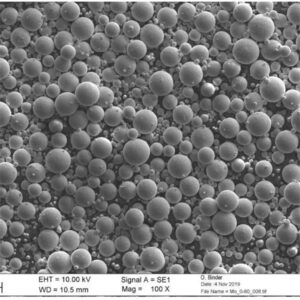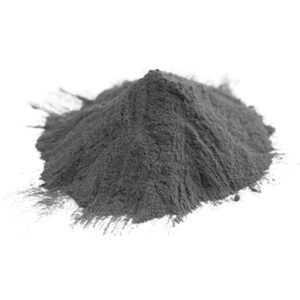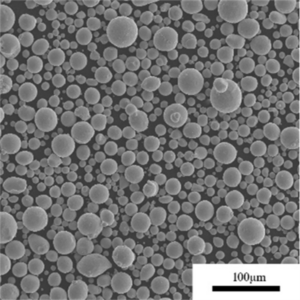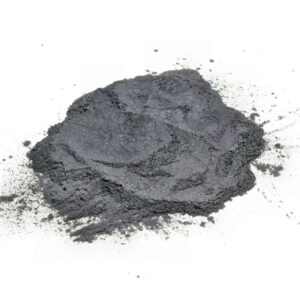개요 적층 제조 분말
적층 제조 파우더는 선택적 레이저 용융(SLM), 직접 금속 레이저 소결(DMLS), 전자빔 용융(EBM), 바인더 제팅 등의 3D 프린팅 기술을 위해 특별히 분말 형태로 생산된 금속 합금 재료를 말합니다. 최적화된 입자 크기 분포, 형태, 화학 및 분말 특성으로 최종 사용 부품에 층별로 정밀하게 융합할 수 있습니다.
표 1: 적층 제조 파우더 속성 개요
| 속성 | 설명 |
|---|---|
| 공급 원료 재료 | 구형 금속 합금 입자 |
| 생산 방법 | 가스 분무, 전기 분해, 카보닐 |
| 사용된 재료 | 티타늄, 알루미늄, 스테인리스강, 초합금, 공구강 |
| 입자 크기 | 일반적으로 10~45미크론 |
| 주요 속성 | 유동성, 밀도, 미세 구조, 순도 |
| 주요 애플리케이션 | 항공우주, 의료, 자동차, 산업 |
입자 모양, 크기 분포, 화학 및 미세 구조와 같은 특성을 세심하게 제어한 덕분에 적층 제조 분말은 원활하게 흐르고 조밀하게 포장되며 층마다 일관되게 융합되어 기존 제조 방식과 같거나 그 이상의 기계적 특성을 지닌 복잡하고 견고한 금속 부품을 제작할 수 있습니다.
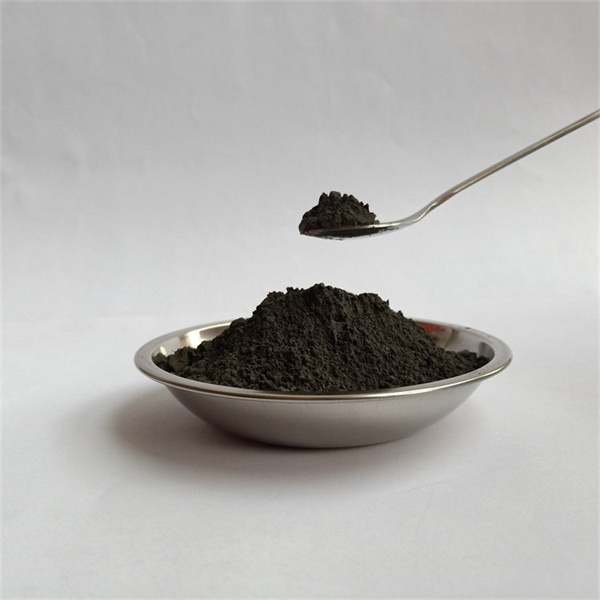
적층 제조용 금속 분말 생산 방법
적층 가공 분말은 여러 가지 주요 생산 경로를 활용하여 적층 가공 공정에 필요한 화학, 입자 형성, 표면 형태, 다공성 수준 및 입자 분포 사양을 갖춘 미세한 구형 분말을 생성합니다.
표 2: 적층 제조 분말 생산 방법 비교
| 방법 | 설명 | 장단점 |
|---|---|---|
| 가스 분무 | 고압 가스가 용융 금속 흐름을 물방울로 분해합니다. | 균일한 입자, 합금 유연성 단점은 높은 비용입니다. |
| 플라즈마 분무 | 전극 아크는 금속을 입자로 녹이거나 분해합니다. | 매우 구형 분말, 소량 배치 |
| 수화물-수화물 | 수소 흡수를 통한 합금 분말 감소 | 유동성은 좋지만 밀도가 낮은 매우 미세한 분말 |
| 전기 분해 | 양극에서 분말로 용해된 금속 공급 원료 | 비용은 저렴하지만 불규칙한 벗겨지는 형태 |
AM 하드웨어 성능이 발전하여 20미크론까지 더 미세한 해상도가 가능해짐에 따라 15~45미크론을 중심으로 더 엄격한 분말 입자 크기 분포가 중요해졌으며, 가스 및 플라즈마 원자화를 통해 구형 운석 분말이 고밀도 포장과 부드러운 레이크에 이상적으로 적용될 수 있게 되었습니다.
생산 경로를 의도된 AM 공정 요구 사항과 일치시켜 성능 트레이드 오프의 균형을 맞추는 최적의 파우더 사양을 보장합니다.
금속 적층 제조 분말의 종류
분말 형태로 생산되는 다양한 금속 합금은 이제 주조 또는 가공의 한계를 뛰어넘는 물성 성능과 더불어 부품 통합을 용이하게 하는 향상된 설계 자유도 덕분에 저렴한 폴리머부터 고가의 내화성 초합금에 이르기까지 AM 기술 전반에 걸쳐 광범위하게 채택되고 있습니다.
표 3: AM에 활용되는 일반적인 금속 분말 재료
| 머티리얼 클래스 | 합금 유형 | 설명 |
|---|---|---|
| 알루미늄 합금 | AlSi10Mg, AlSi7Mg | 항공우주, 자동차 전반의 경량화 |
| 티타늄 합금 | Ti-6Al-4V, Ti 6Al4V ELI | 고강도 항공 및 생체 의료용 임플란트 |
| 스테인리스 스틸 | 304L, 316L, 17-4PH | 선박용 하드웨어의 내식성 |
| 공구강 | H13, 마레이징 300 | 극한 경도 절삭 공구 및 금형 |
| 니켈 초합금 | 인코넬 718, 인코넬 625 | 항공우주 엔진과 같은 터보 기계류 |
| 이국적인 합금 | 구리, 코발트 크롬, 텅스텐 | 사용자 지정 구성으로 한계를 뛰어넘다 |
최적화된 파우더 베드 융합 환경은 기존의 제조 장애물을 뛰어넘어 전통적으로 까다로운 재료 구성을 처리할 수 있도록 지원합니다. 이를 통해 전자 패키징 열 관리 요구 사항, 극한 환경을 위한 오일 및 가스 밸브와 펌프, 자동차 경주용 부품, 위성 하드웨어 전반에 걸쳐 혁신을 이룰 수 있습니다.
무게, 비용, 강도, 환경 호환성 등 설계 우선순위에 따라 최적의 합금을 신중하게 선택하면 기존 공정으로는 불가능한 이상적인 고성능 적층 부품을 만들 수 있습니다.
적층 제조 분말의 주요 특성
고밀도 결함 없는 인쇄 부품을 구현하는 데 중요한 부드럽고 효과적인 재료 증착을 보장하려면 적층 제조 분말 제품은 흐름 특성, 겉보기 밀도, 잔류 다공성, 미세 구조 및 오염 한계와 관련된 엄격한 요구 사항을 충족해야 합니다.
표 4: 일반적인 금속 AM 파우더 속성
| 특성 | 일반적인 값 | 테스트 방법 | 중요성 |
|---|---|---|---|
| 분말 형태 | 구형에 가까운 부드러운 | SEM 이미징 | 파우더 베드 패킹 및 흐름 |
| 입자 크기 분포 | 10μm - 45μm | 레이저 회절 분석 | 레이어 해상도, 빌드 속도 |
| 겉보기 및 탭 밀도 | 각각 65-80% / 80-92% | 홀 유량계를 통한 중량계 측정 | 인쇄 해상도 및 품질 |
| 유량 | 50g에 23~33초 | 시간 제한 퍼널 테스트 | 파우더 확산 성능 |
| 잔여 다공성 | <1% | 가스 피크노메트리 | 밀도 및 기계적 특성 |
| 산소/N 오염 | <1000ppm / <500ppm | 불활성 가스 분석 | 분말 재사용, 공정 중 균열 방지 |
고급 기기를 사용하여 생산 시 중요한 분말 특성을 확인하면 실시간 통계적 공정 조정을 통해 배치 간 특성 편차를 극복하고 반복성을 높일 수 있습니다.
엄격한 기계 공차에 대해 안정적인 제작 공정을 갖춘 잘 특성화된 파우더를 매칭하면 안정적인 AM 생산 실행이 보장됩니다.
금속 적층 제조 분말 사양
적층 제조 하드웨어 시스템의 고품질 부품을 보장하려면 금속 합금 분말은 압축 및 소결만을 목적으로 하는 기존 분말 야금에 비해 더 엄격한 화학적 제어와 치수 분포를 준수해야 합니다.
표 5: 일반적인 첨가제 분말 사양 값
| 매개변수 | 공통 범위 | 테스트 방법 | 중요성 |
|---|---|---|---|
| 입자 크기 분포 | 15μm - 45μm | 레이저 회절 | 최소 기능 해상도 제어 |
| 원소 불순물 | <1000 ppm | ICP 분광법 | 파우더 재사용 비율 |
| 겉보기 밀도 | 65-85% 이론적 | 홀 유량계를 통한 중량 측정 분석 | 기계적 성능에 영향을 미침 |
| 탭 밀도 | 80-95% 이론적 | 중량 측정 분석 | 레이어 패킹 비율 |
| 홀 유량 | <파우더 50g의 경우 40초 미만 | 시간 제한 퍼널 테스트 | 파우더 베드 퍼짐 일관성 |
| 파티클 모양 | >80% 구형 | SEM 이미징 | 파워 베드 유동화 균일성 |
| 잔여 다공성 | <1% | 가스 피크노메트리 | 밀도 및 기계적 특성 |
금속 AM 파우더를 위해 개발된 고급 균일성 계수 및 유량 비율 공식을 모니터링하면 단순한 홀 흐름만으로는 신뢰할 수 없는 애플리케이션 성능을 보장하는 보다 심층적인 통찰력을 얻을 수 있습니다.
또한 특별히 크기 분포를 맞춤화함으로써 분말 화학 물질 공급은 더 미세한 해상도, 더 빠른 제작 속도, 더 긴 무중단 생산 실행을 추구하는 공정 개선을 적극적으로 지원하여 적층 제조 도입에 필수적인 공정 개선을 촉진합니다.
적층 제조 분말의 등급 및 표준
적층 제조가 항공우주, 의료, 자동차 및 산업 분야를 아우르는 규제 환경에 침투함에 따라 금속 분말을 지정, 테스트, 인증 및 제어하는 표준화된 방법은 반복성, 품질 및 안전을 보장하는 데 필수적입니다.
표 6: 금속 적층 제조 분말에 대한 새로운 표준
| 표준 | 범위 | 목적 |
|---|---|---|
| ASTM F3049 | 적층 제조 분말 특성 분석을 위한 표준 가이드 | 일반적인 분말 특성을 평가하는 벤치마크 테스트 방법 수립 |
| ASTM F3056 | 니켈 합금 분말 사양 | 화학, 제조, 재시험 빈도 |
| ASTM F3301 | AM 부품에 적용되는 2차 공정 방법 실습 | 허용되는 후처리 기술 지정 |
| AS9100 rev D | 항공우주 부문 승인 공급업체 | 규제 대상 산업을 위한 품질 시스템 |
| ISO/ASTM 52921 | AM에 대한 표준 용어 - 글로벌 표준과 일치 | 통합된 AM 파우더 재료 용어 및 사양 보장 |
엄격한 검증과 부품 추적이 필요한 상업 및 방위 산업에 적층 제조가 더욱 확산됨에 따라 표준화된 테스트 관행, 관리 문서, 로트 샘플링 비율, 시설 환경 제어 및 직원 교육이 의무화되고 있습니다. 규정 준수는 사용자에게 완전한 재료 혈통과 공정 투명성을 보장하여 중요한 애플리케이션에서 기대되는 엄격한 검증을 용이하게 합니다.
또한 정부 기관은 다양한 시장에서 3D 프린팅이 발전함에 따라 재료 사양, 테스트 기술 및 모범 사례에 대한 지속적인 개발을 지원합니다. 파우더 제조업체, 프린터 OEM, 산업 사용자 간의 협력은 실제 성능과 신뢰성을 개선하는 벤치마킹 개선을 지속적으로 추진할 것입니다.
금속 첨가제 분말의 응용 분야
확장된 프린터 시스템 성능과 적층 제조 요구에 최적화된 파우더의 가용성 덕분에 적층 제조는 항공 우주부터 소비재에 이르기까지 다양한 산업 분야에서 생산 경제성을 혁신하고 있습니다.
표 7: 1차 금속 적층 제조 분말 응용 분야
| 섹터 | 제조 공정 예시 | 비용 대비 성능 이점 |
|---|---|---|
| 항공우주 엔진 | DMLM을 통한 인코넬 718 노즐 및 매니폴드 | 리드 타임 단축, 바이투플라이 비율 개선 |
| 항공 터빈 | EBM을 통한 Ti64 구조용 브래킷 | 무게 절감, 부품 통합 |
| 바이오메디컬 임플란트 | DMLS의 코발트 크롬 정형외과 | 뼈 통합률 증가 |
| 자동차 레이싱 | SLM을 통한 맞춤형 합금 및 지오메트리 | 높은 내열성/내진동성 및 무게 절감 효과 |
| 명품 시계 | SLM의 금 및 강철 마이크로 부품 | 디자인/스타일링의 자유와 빠른 반복 작업 |
금속 3D 프린팅은 재료 옵션이 확대되고 제작 가능 용량이 커지면서 기존 공정이 직면한 생산 장벽을 혁신하여 고강도 경량화, 생성 냉각 채널을 통한 내열성 향상, 부품 통합 및 총 리드 타임 단축을 가능하게 합니다.
이러한 제조상의 이점은 규모의 경제가 실현되면 비용에 민감한 산업 전반에서 기존 생산을 대체하는 적층 제조 기술의 채택을 촉진할 것입니다. 지속적인 재료 혁신은 극한의 화학, 압력, 부식성 및 하중 환경으로 응용 분야를 확장할 수 있을 것으로 기대됩니다.
금속 AM 분말 공급업체
현재 다양한 파우더 제조업체가 소규모 작업장의 스타터 장비부터 대형 티어 1 항공우주 공급업체 및 AM 기능의 한계를 뛰어넘는 맞춤형 합금 혁신업체에 이르기까지 적층 제조에 필요한 특수 금속 소재를 공급하고 있습니다.
표 8: 첨가제 공급업체를 위한 주요 금속 분말
| 회사 | 포트폴리오 | 설명 |
|---|---|---|
| 프렉스에어 | 티타늄, 니켈, 코발트 합금 | 분무 가스 및 분말의 선도적 생산업체 |
| 샌드빅 | 스테인리스 스틸 | 듀플렉스 및 마레이징 강을 포함한 고성능 합금 |
| LPW 기술 | 알루미늄, 티타늄, 니켈 합금 | 맞춤형 합금 및 바인더 제품 |
| 목수 첨가제 | 공구강, 스테인리스강 | 제강 전문 지식을 활용한 맞춤형 합금 |
| AP&C | 티타늄, 니켈 초합금 | 분말 수명 주기 솔루션 제공업체 |
| 호가나스 | 스테인리스 스틸 | 듀플렉스 및 마레이징 강을 포함한 고성능 합금 |
이러한 파우더 리더들은 프린터 OEM, 연구원 및 표준화 그룹과 함께 적층 제조 산업 내에서 적극적으로 협력하여 치수 반복성을 지속적으로 개선하고 다공성 비율을 줄이며 완성 부품의 미적 및 기계적 사양을 향상시킵니다.
금속 AM 분말의 비용 분석
일반적인 금속 적층 제조 분말의 가격은 구성, 생산 경로, 유통 단계, 테스트 요구 사항, 구매량에 따라 크게 달라지지만 일반적으로 프레스 및 소결 용도에만 사용되는 기존 분말에 비해 상당한 프리미엄이 붙습니다.
표 9: 금속 첨가제 분말 가격
| 재질 | 가격 범위 | 비용 동인 |
|---|---|---|
| 알루미늄 합금 | $50-120kg당 | 투입 금속 비용은 낮지만 가스 분무기 비용은 높음 |
| 스테인리스 스틸 | $50-200 kg당 | 316L은 17-4 또는 15-5 등급보다 더 비쌉니다. |
| 공구강 | $60-220 kg당 | 더 높은 합금 원소 비용 |
| 티타늄 합금 | $200-600 kg당 | 처리 집약적인 추출 및 처리 |
| 니켈 초합금 | $200-1000 kg당 | 낮은 소자 수율과 크랙 없는 인쇄 능력은 매우 중요합니다. |
| Ta 또는 W와 같은 이국적인 | $500-2000 kg당 | 현재 매우 낮은 글로벌 출력 가용성 |
기존 분말보다 훨씬 낮은 배치 크기, 높은 재료 투입 비용, 구형성 및 제어된 화학적 특성과 같은 특성을 최적화하는 공정 차이로 인해 적층 제조 요구 사항을 충족하는 데 있어 기존 분말에 비해 가격 프리미엄이 발생합니다.
프린터 채택이 확대됨에 따라 경쟁이 치열해지고 제조 규모가 커지면서 일반적인 기술 성숙 로드맵에 따라 5~10년에 걸쳐 점진적으로 비용이 절감될 가능성이 높습니다. 그러나 특수 등급은 기본 금속 투입 시장 역학을 반영하여 가격이 상당히 높게 유지될 것입니다.
자주 묻는 질문
Q: 사용/재활용된 금속 AM 파우더는 추가 프린팅 주기를 위해 어떻게 재생되나요?
A: 파우더를 체질하여 100마이크론 이상의 큰 입자를 제거하고, 화학적으로 재조정하여 산소/질소 수준을 복원하며, 최종 인쇄 부품 품질 저하 없이 적절한 재사용을 보장하는 비율의 버진 재료와 혼합합니다.
Q: AM과 기존 프레싱 파우더의 가장 큰 차이점은 무엇인가요?
A: 평균 25미크론의 좁은 입자 크기 분포, 더 높은 겉보기 및 탭 밀도, 더 매끄러운 구형 운석 분말 모양, 더 낮은 산소 및 질소 수준은 더 느슨한 허용 오차만 요구하는 기존 분말 야금에 비해 AM 요구 사항을 차별화합니다. 이러한 최적화된 특성을 달성하면 결함 없는 3D 프린팅이 가능합니다.
Q: 일반적인 AM 파우더 합금은 일반적으로 몇 번까지 재사용할 수 있나요?
A: 유사한 티타늄 및 니켈 초합금은 새로운 파우더로 보충해야 하기 전에 20주기에 가까워집니다. 가격이 저렴한 스테인리스 스틸은 재사용 주기가 50회 이상에 달할 수 있습니다. 알루미늄 및 반응성이 높은 등급의 경우 재활용 주기가 대부분 5회 미만으로 제한됩니다.
Q: 금속 AM 파우더는 기존 재료에 비해 어떤 물성 향상 잠재력이 있나요?
A: 유체 흐름, 열 전달 또는 구조적 보강을 촉진하는 임베디드 채널과 함께 섹션을 얇게/중공화하여 중량 대비 강도를 높임으로써 감산 가공 또는 단일 단계 주조 공정만으로는 불가능한 제조 부품의 혁신적인 설계 구성이 가능해집니다.
Q: 현재 금속 AM 파우더의 성장 가능성이 가장 큰 산업 분야는 어디인가요?
A: 항공우주, 의료 기기, 자동차, 석유/가스 부문은 R&D 투자를 정당화하는 고부가가치 부품 덕분에 초기 메인스트림 확장을 주도하고 있습니다. 그러나 장기적으로는 시스템 비용이 감소함에 따라 적층 제조의 유연성 이점을 활용하여 소비재 내구성을 개선하는 분야가 궁극적으로 대량 채택될 것으로 예상됩니다.

